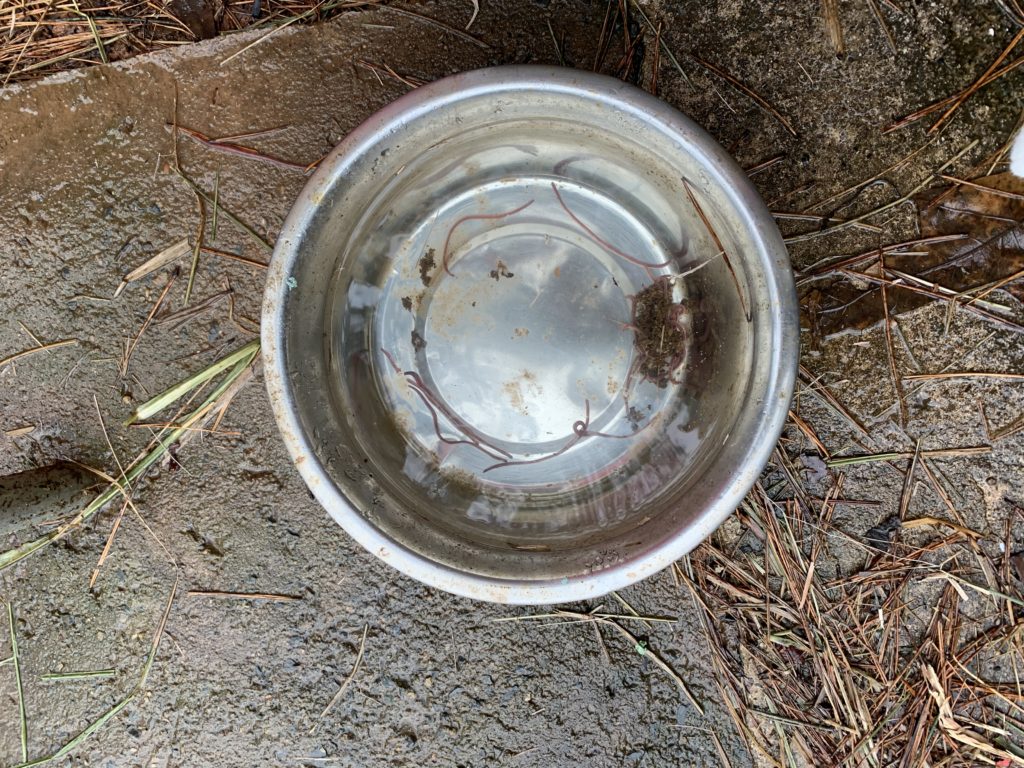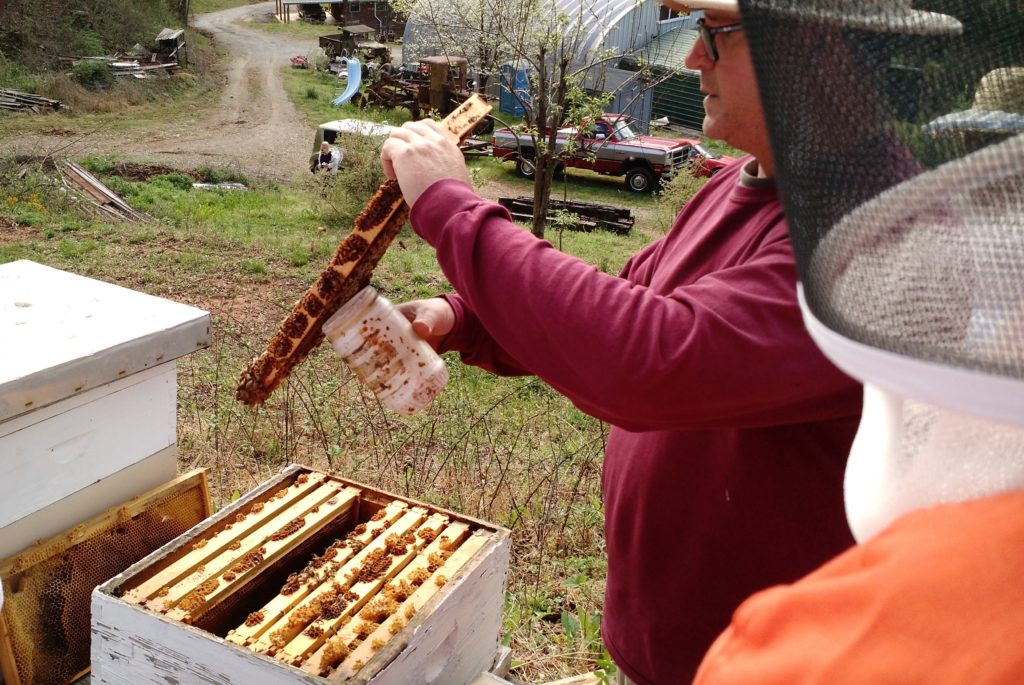Horsehair Worms, Varroa Mites and More…
go.ncsu.edu/readext?644650
en Español / em Português
El inglés es el idioma de control de esta página. En la medida en que haya algún conflicto entre la traducción al inglés y la traducción, el inglés prevalece.
Al hacer clic en el enlace de traducción se activa un servicio de traducción gratuito para convertir la página al español. Al igual que con cualquier traducción por Internet, la conversión no es sensible al contexto y puede que no traduzca el texto en su significado original. NC State Extension no garantiza la exactitud del texto traducido. Por favor, tenga en cuenta que algunas aplicaciones y/o servicios pueden no funcionar como se espera cuando se traducen.
Português
Inglês é o idioma de controle desta página. Na medida que haja algum conflito entre o texto original em Inglês e a tradução, o Inglês prevalece.
Ao clicar no link de tradução, um serviço gratuito de tradução será ativado para converter a página para o Português. Como em qualquer tradução pela internet, a conversão não é sensivel ao contexto e pode não ocorrer a tradução para o significado orginal. O serviço de Extensão da Carolina do Norte (NC State Extension) não garante a exatidão do texto traduzido. Por favor, observe que algumas funções ou serviços podem não funcionar como esperado após a tradução.
English
English is the controlling language of this page. To the extent there is any conflict between the English text and the translation, English controls.
Clicking on the translation link activates a free translation service to convert the page to Spanish. As with any Internet translation, the conversion is not context-sensitive and may not translate the text to its original meaning. NC State Extension does not guarantee the accuracy of the translated text. Please note that some applications and/or services may not function as expected when translated.
Collapse ▲This week I would like to share some questions that were recently asked at the N.C. Cooperative Extension, Caldwell County Center. I hope you find these questions and answers helpful. If you have specific questions not answered here, please contact me and my team at the Caldwell County office.
Question: This will sound crazy but I have a problem with worms. These worms are 2-3 inches and slender. They look sort of like earthworms but aren’t as fat. They end up in my cats water bowl. I thought they fell off the roof of the barn. They swim in the bowl. They are also between my garage door and the floor. Hundreds of them. I don’t know if I need to get rid of them. One of my horses had roundworms recently but they were bigger. The whole worm thing is disturbing since my horse had some. Any ideas?

These worms are called horsehair worms. They are actually parasites of crickets. They are not harmful to pets, livestock, or people. (Photo Credit Ann Winkler)
Answer: These are horsehair worms. They are a parasite of crickets and beetles.
Horsehair worms belong to the group Nematomorpha. They are similar to nematodes (microscopic worms) but much longer (4 inches or longer) and very thin (1/80 to 1/10 inch diameter). They are found in water or wet areas, such as alongside streams or puddles but they can occur in cisterns, livestock watering troughs, or other outdoor water containers.
These harmless, curious creatures writhe slowly, contorting their hair-like bodies into intricate knots. Horsehair worms develop as parasites in the bodies of grasshoppers, crickets, cockroaches, and some beetles. When mature, they leave the host to lay eggs. They are not parasites of humans, livestock, or pets. They pose no public health threat.
The name “horsehair worm” refers to the old belief that they came from horse hairs that fell into water and came to life. Cabbagehair worm is another name for these worms because they can be found in the water droplets that collect in cabbage leaves. Since they are usually contorted into “knots”, the name Gordian worm was used by some. According to Greek legend, King Gordius of Phrygia tied a complicated knot. The first person to untie it would be the future ruler of Asia. Alexander the Great was not able to untie the knot so he cut through it with his sword.
Question: I have kept bees all my life. This fall I had 18 strong hives. Now there are no bees in any of my hives. What happened to the bees?
Answer: Unfortunately I have been asked this question too many times. It is the same story. The colony was big and looked healthy in the fall. The bees had plenty of honey. Then the colony just disappeared.
Many people want to use the term colony collapse for this type of death. Collapse is a good descriptor of what happens, but this is not true colony collapse disorder. This is death by varroa mites (Varroa destructor) and their associated viruses.
Varroa mites are an external parasite of honeybees. They affect honeybees by attacking the adult bees and the developing bee larvae. These mites are reddish-brown, flat, oval-shaped, and about the size of the head of a straight pin.
Female adult mites lay their eggs into the cell of a developing bee larvae. The mites hatch and feed on the developing bee. This causes deformity or even death of the developing bee. As bad as feeding on the developing bee is, the viruses that the mites transmit to the bees are even worse.
Traditionally strong bee hives survived the winter and did best the following spring. However, strong colonies also have more developing bees. Mites need developing bees to reproduce. So now strong hives are at risk of not surviving the winter because of potential mites and their associated viruses. This is counterintuitive to think the strong hives are at risk for not making it through the winter.
The varroa mite is the most serious pest of honey bee colonies worldwide. This parasite was first detected in North Carolina in 1990, having been introduced to the United States just three years earlier. Virtually all feral (or “wild”) honey bee colonies have all but been wiped out by these mites. In North Carolina managed beehives have dropped by an estimated 44 percent since the invasion of the mites. It is vital beekeepers understand the varroa mite and its management to be a successful beekeeper.
A new tool for beekeepers that is as essential as the smoker, veil, or hive tool is the sugar shake jar. This simple sugar shake jar is used to assess the mite population in a hive.

N.C. Department of Agriculture & Consumer Services – Apiary Inspector Bee Inspector – Lewis Cauble demonstrates to members of the Caldwell Co Beekeepers Association how to monitor for varroa mites using a sugar shake method. Lewis is using a peanut butter jar to collect one cup of bees from the brood area of the hive. One cup of bees is about 300 bees. (Photo Credit Seth Nagy)
There are pesticide treatments for mites. However, some miticides are no longer effective against some mite populations. Monitoring mite populations with a sugar shake jar (or other method) is essential to know which hives need to be treated. It is also as important to check and confirm the mite treatment was effective. Monitoring mite populations is essential for all long term beekeepers.
Question: I heard there is a new requirement to buy paraquat?
Paraquat-dichloride is the active ingredient of a non-selective herbicide. This product is sometimes used by crop farmers to kill weeds prior to planting. This is called a burn down application. Some trade names of products that contain paraquat are Gramoxone, Para-SHOT, Parazone, Quick-Quat, Firestorm or Helmquat.
Paraquat is a restricted use pesticide. Applicators have to have a pesticide license to purchase or use this product. The US Environmental Protection Agency (EPA) restricts the use of pesticides for only two reasons. Either the product is potentially hazardous to the environment if applied incorrectly or it is poisonous to the applicator.
In this case, paraquat is a restricted use pesticide because it is potentially poisonous to the applicator. All pesticides are labeled with signal words to indicate how poisonous they are to people. These signal words do not indicate how effective the product is at killing pests, only how poisonous it is to people. The three signal words are:
CAUTION – Products with the signal word CAUTION are lower in toxicity. A “CAUTION” label means the pesticide product is slightly toxic if eaten, absorbed through the skin, inhaled, or it causes slight eye or skin irritation.
WARNING – Indicates the pesticide is moderately toxic if eaten, absorbed through the skin, inhaled, or it causes moderate eye or skin irritation.
DANGER – Means that the pesticide product is highly toxic by at least one route of exposure. It may be corrosive, causing irreversible damage to the skin or eyes. Alternatively, it may be highly toxic if eaten, absorbed through the skin, or inhaled. If this is the case, then the word “POISON” must also be included in red letters on the front panel of the product label.
In addition to the signal word “DANGER” there can also be a picture of a skull and crossbones. This is the most poisonous category of pesticides to people.
The pesticide label of paraquat has changed and now requires applicators to have additional training. The requirement applies not only to applicators, but also to anyone who handles the newly labeled paraquat in any way, including mixing, loading, applying, transporting, disposing of or cleaning containers of the herbicide. Noncertified persons working under the supervision of a certified applicator are prohibited from handling paraquat in any way.
Applicator training is available online.
If you have agricultural questions, contact the N.C. Cooperative Extension, Caldwell County Center at 828-757-1290, or email me at seth_nagy@ncsu.edu.




